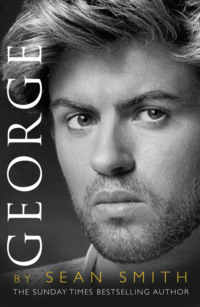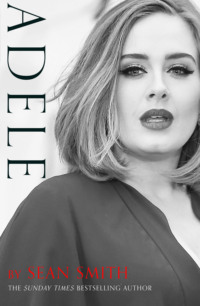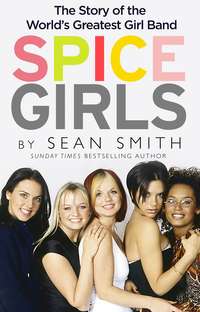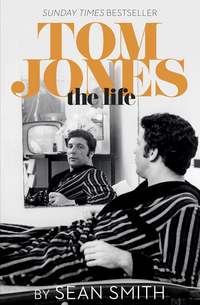
Полная версия
Ed Sheeran

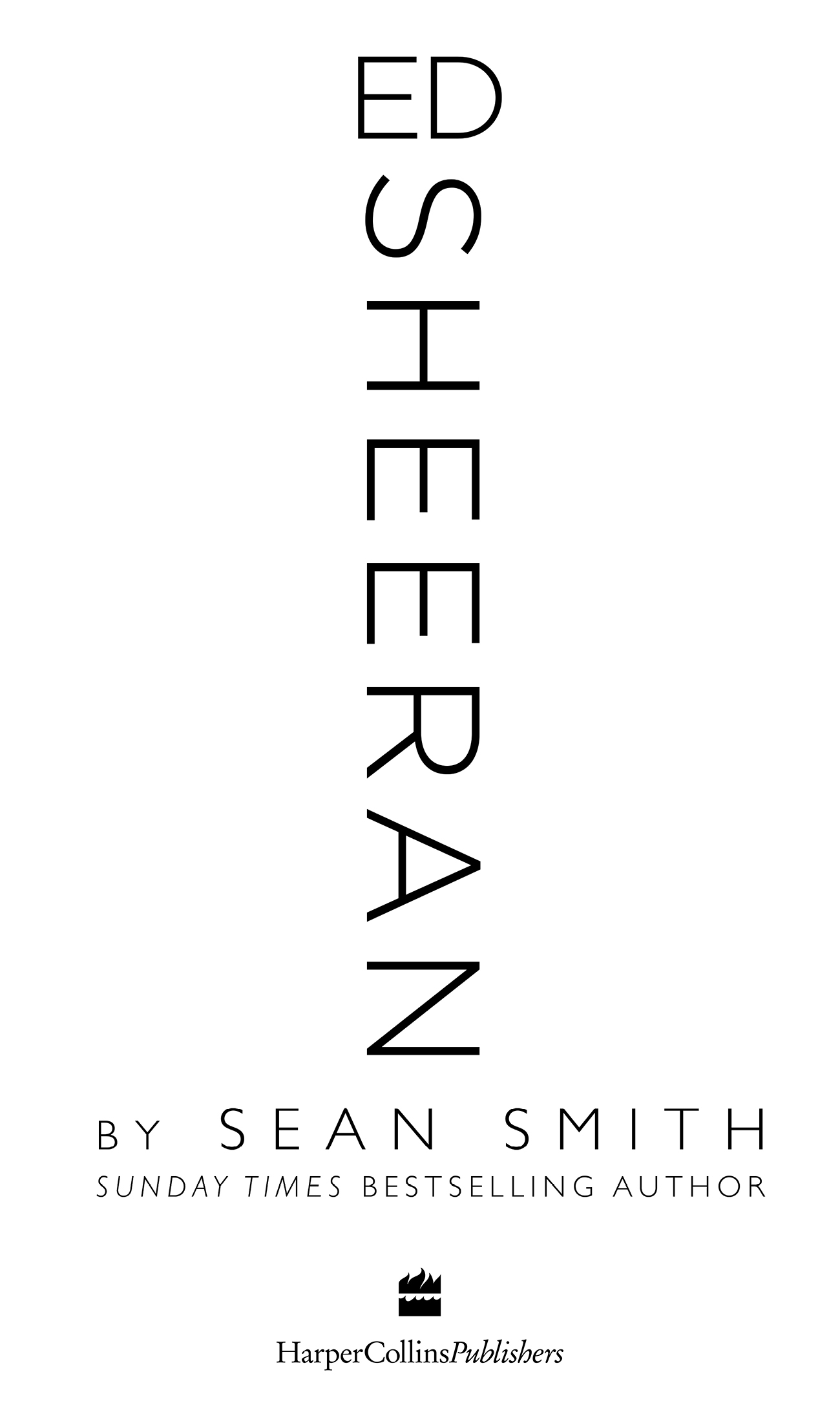
Copyright
HarperCollinsPublishers
1 London Bridge Street
London SE1 9GF
www.harpercollins.co.uk
First published by HarperCollinsPublishers 2018
FIRST EDITION
Text © Sean Smith 2018
Jacket design by Claire Ward © HarperCollinsPublishers Ltd 2018
Jacket photograph © Jesse Dittmar/Redux/eyevine
A catalogue record of this book is available from the British Library
Sean Smith asserts the moral right to be identified as the author of this work
While every effort has been made to trace the owners of copyright material reproduced herein and secure permissions, the publishers would like to apologise for any omissions and will be pleased to incorporate missing acknowledgements in any future edition of this book.
All rights reserved under International and Pan-American Copyright Conventions. By payment of the required fees, you have been granted the nonexclusive, non-transferable right to access and read the text of this e-book on screen. No part of this text may be reproduced, transmitted, downloaded, decompiled, reverse engineered, or stored in or introduced into any information storage retrieval system, in any form or by any means, whether electronic or mechanical, now known or hereinafter invented, without the express written permission of HarperCollins e-books.
Find out about HarperCollins and the environment at
www.harpercollins.co.uk/green
Source ISBN: 9780008267513
Ebook Edition © November 2018 ISBN: 9780008267551
Version: 2018-11-05
Also by Sean Smith
George
Adele
Kim
Tom Jones: The Life
Kylie
Gary
Alesha
Tulisa
Kate
Robbie
Cheryl
Victoria
Justin: The Biography
Britney: The Biography
J.K. Rowling: A Biography
Jennifer: The Unauthorized Biography
Royal Racing
The Union Game
Sophie’s Kiss (with Garth Gibbs)
Stone Me! (with Dale Lawrence)
Dedication
For Hilaria
Contents
Cover
Title Page
Copyright
Also by Sean Smith
Dedication
Introduction: Principality Stadium, Cardiff, 24 June 2018
PART ONE: FAMILY IS ALL
1 Painting the Picture
2 Pugilism not Vandalism
3 The Eminem Remedy
4 Spinning Man
5 The Loopmeister
6 Want Some Nizlopi
7 Ed Stage Left
8 Access All Areas
PART TWO: THE NEXT BIG THING
9 Singer–Songwriter
10 In the City
11 Loose Change
12 A Fine Example
13 A Big Deal
14 Wayfaring
15 Precious Moments
PART THREE: THE SHAPE OF THINGS
16 On Patrol
17 Moving Swiftly On
18 The Universal Shush
19 Thinking Out Loud
20 Home and Away
21 Perfect Symphony
Last Thoughts
Ed’s Stars
Life and Times
Acknowledgements
Select Bibliography
List of Searchable Terms
Picture Section
About the Publisher
INTRODUCTION
Principality Stadium, Cardiff, 24 June 2018
He’s on time. There’s no messing about with Ed. He doesn’t need to build up the excitement artificially by being late onstage. Instead, at 8.45 p.m. precisely, the lights go down and the video screens show him making his way casually down a corridor towards the stage as if he’s strolling to the pub for a pint. The only giveaway that this is an extraordinary event is the deafening roar from 60,000 people.
And there’s the man himself. The pedals of his famous loop station are at his feet and a small guitar bearing the logo of his latest album ÷ (Divide) is in his hands. He cuts a solitary figure. If you didn’t know he was the biggest pop star in the world in 2018, you’d be forgiven for thinking this was the warm-up act who couldn’t afford a proper band.
Standing a couple of rows in front of me, a young girl has the symbol ÷ etched in glitter on her cheek. I’m surrounded by people wearing official T-shirts with the logo on the front and the cities he’s playing on the back. This will please Ed, who has always been switched on regarding the promotional and financial importance of official merchandise. As a schoolboy, he would try to flog a few of his self-financed CDs to his audience, even if it was just half a dozen people in a social club.
The first chords of ‘Castle on the Hill’ are all anybody needs to get up and dance. Ed Sheeran is only one man but he seems to create an enormous power and charisma. There’s nobody else quite like him. Not everyone was brought up in a small town with a view of a magnificent castle, but we can all identify with thoughts and feelings about home. There’s something reassuring about making your way back, perhaps at Christmas or just to see Mum and Dad or old friends who haven’t moved on.
While he’s getting his breath back, Ed announces, ‘Good evening, Cardiff! Howya doing?’, which is not especially original but meets with a very positive response. Ed’s very relaxed between songs. The night before, he had left the stage twice to go for a pee.
He didn’t need to do that tonight. Instead, he tells us this is the biggest tour that has ever come to Wales. More than 240,000 people have swarmed into the stadium to see him during the last four nights. Apparently, Friday night was the largest single audience, although, to loud cheers, Ed suggests that tonight’s crowd is even bigger.
It’s the last night of the UK leg of his 2018 world tour. I wonder idly if I’m the millionth person to see him since he played the Etihad Stadium in Manchester last month. It’s not just a million teenage girls either. This is truly a family event with mums and dads, nans, grandads and children under ten all eager to enjoy themselves.
I’m next to a young couple from Barry Island who have brought their seven-year-old son Theo with them. ‘Who’s the fan?’ I ask. They chorus that they all are, although Dad told me he usually preferred Iron Maiden and Def Leppard.
He would have enjoyed the start of ‘Eraser’, the opening track on the ÷ album that begins with a wall of sound, courtesy of the loop station. It’s the first number of the night to feature some trademark rapping. In Ed’s hands, rapping seems to be more poetic than aggressive. He has made the genre acceptable to millions who might not have appreciated it before.
He launches into ‘The A Team’, the song he wrote ten years ago that changed everything for him. ‘If you know the words, then sing along,’ he says. It seems as if 60,000 people do. ‘There’s no such thing as “Can’t sing”,’ he tells us, ‘only “Can’t sing in tune”.’ That is certainly the case of practically everyone near me, but nobody cares.
Cleverly, he merges ‘Don’t’ from his second album, × (Multiply), with ‘New Man’ from ÷, both harsh and slightly bitter break-up songs. Between numbers, Ed may not have the distinctive patter of Adele but he chats in a relaxed fashion that appears perfectly natural and friendly, not at all scripted.
Apparently, he last played in Cardiff in 2011 and vowed then that he wouldn’t come back until he could fill this great stadium. That ambition didn’t take long to achieve.
He asks for our biggest scream before changing pace to ‘Dive’ perhaps the most underrated song on ÷. It’s a romantic ballad but not a soppy one. ‘Don’t call me baby/unless you mean it’ is a chorus to sing at the top of your voice in the shower.
As each song passes, I’m more and more struck by how everyone knows the words. I suppose it’s an indication of the sheer scale of his popularity. Ed’s strategy is that it’s a participation show and he wants everyone to sing and dance, although he reminds us that he can’t dance – even if the famous video to ‘Thinking Out Loud’ gives the impression that he’s a natural.
Ed wants us all to dance whether we can or not. Amusingly, he points out that there is always two per cent of an audience that refuses to sing or dance. They’re either the grumpy reluctant boyfriend or the ‘superdad’ who’s being a hero acting as chaperone for their son or daughter. Ed’s own dad, John Sheeran, was exactly that, taking his boy along to countless gigs that gave him a vitally important musical education when he was young enough to absorb any influences.
Ed moves easily between different styles, often in the same song. They might build from a rap or a quiet verse into one of those anthemic choruses you can’t get out of your head. He sings three songs in a row that reflect the agony of love. ‘Bloodstream’, from the × album, starts quietly before transforming into one of his most dramatic crescendos and a powerful wall of sound.
‘Happier’ is, for me, his most melancholy song, a story of love lost, a recurring theme with Ed. The poignant lyric touches anyone who has ever taken a wrong turn in love – and that would be everyone. ‘I’m a Mess’ is another song that reflects Ed’s own intelligence and openness in his lyrics. I wish I had a fiver for every time someone’s told me that they like the autobiographical touches he includes in his songs.
It’s time to lighten the mood a little and ‘Galway Girl’ does exactly that. Some critics don’t like this song and I’ve heard it described as Marmite – you either love it or you hate it – but we’re all up, having a hooley in the aisles. Ed has always embraced his Irish heritage and my guess is that this will become a party classic in the years ahead.
Ed doesn’t do many covers so it’s a surprise when he slips ‘Feeling Good’ into the set list. Although many people know it as a Michael Bublé song from a decade ago, it’s actually a much older stage-musical number that became an instant classic when it was recorded by the matchless Nina Simone in 1965. The late George Michael also featured it on his last studio album, Symphonica, in 2014. I wonder if there are any similarities between Ed and George – arguably the two greatest solo male pop stars the UK has produced. Ed cleverly mashes his version into the haunting ‘I See Fire’, the song he wrote for the 2013 film, The Hobbit: The Desolation of Smaug.
Ed changes guitars for practically every number. He is handed an electric guitar for the first time and mentions Amy Wadge, one of his original collaborators, who still lives locally in South Wales and is in the audience tonight. ‘If you don’t know the words to this one then you’re probably at the wrong show,’ he announces, then plays the opening chords of the sublime ‘Thinking Out Loud’, which he wrote with Amy.
Everyone goes into a huge romantic sigh. Instead of the thousand stars in the lyric, I can see a thousand and more torch lights from mobile phones shimmering in the darkened stands. Considering that he has only released three mainstream albums, Ed has already produced many classics – songs that will be first dances at weddings, reminders of first dates and kisses or just simply ‘our songs’.
This is the beginning of four peerless ballads. He follows ‘Thinking Out Loud’ with ‘One’ and ‘Photograph’, also from the × album. During the latter, the big screens behind him flash up images of Ed as a child. Could it get any more poignant? And then he plays ‘Perfect’.
Ed explains one of his secrets. This song is ‘super-personal to me’, he reveals. We know it’s written for Cherry but it doesn’t have the same emotion for everyone: ‘It’s my song before it comes out, but when it comes out, it becomes your song.’ This is a universal truth about music.
As if to prove that point, the grey-haired couple behind me put their arms around each other. The young mum next to me picks up her son and cuddles him, while a few rows down I can see a small boy standing between his mum and dad and they all have their arms around each other. It’s an ‘I was there’ moment that they will always remember. Perfect, indeed.
‘Nancy Mulligan’, the song he wrote about his Irish grandparents, wakes everyone from their romantic reverie and we all start dancing again – all except one superdad I spotted, who was determined to stay seated while his young daughter bopped away enthusiastically next to him. Even he got up for ‘Sing’, the closing number.
Ed pops offstage briefly to change his shirt. He’s back wearing a number-eleven jersey with Gareth Bale on the back, which gets a cheer. The reception for the first number of the encore, his biggest hit to date – ‘Shape of You’ – is the loudest of the night. He finishes with a frantic wall-of-noise version of ‘You Need Me, I Don’t Need You’, which is the song he traditionally performs as his last of the night.
Part of me thinks he should have ended with ‘Thinking Out Loud’ or ‘Perfect’, but that’s clearly not what he’s decided to do. He wants to leave with a dramatic climax, and that he achieves. This is the song that sums up his philosophy: be true to your own dreams and follow them. He wishes us a safe journey home and is gone – no fuss, no unnecessary milking of the applause, no insincere ‘I love you, Cardiff’ nonsense. He came, he played, he conquered.
On my way out with 60,000 other people, I thought about the end of the video for ‘Photograph’, perhaps my favourite. There’s a shot of Ed at the top of a hill and a voice asks, ‘Are you at the top of the mountain?’ His phenomenal success – in terms of record sales, downloads, streaming, audience figures – doesn’t lie. He is unarguably at the top of the mountain, looking down on the rest of the music business. My job, I thought, is to discover how on earth a scruffy, ginger-haired bloke climbed up there.
1
Painting the Picture
Undeniably, Edward Sheeran was a cute baby. The proof is in the many home movies his doting parents, John and Imogen, took of their second son as he crawled and gurgled, whooped and squealed around their first family home.
The footage was used charmingly in the nostalgia-packed video that accompanied his 2014 ballad ‘Photograph’. While the sweet film had little to do with a melancholic lyric that declared how much ‘loving can hurt’, it provided a fascinating window on to his world.
We see Ed grow from baby to small boy, with ginger hair, large blue NHS specs and a small port-wine stain near his left eye, to a teenager busking in the street while learning his craft and, finally, to the man acknowledging the applause of thousands at a pop festival.
The large late-Victorian stone house that is the setting for many of the clips is not, however, in his beloved Suffolk, the county so closely associated with Ed, but in West Yorkshire where he was born, and where he spent his early years in the cosmopolitan market town of Hebden Bridge.
John and Imogen Sheeran lived halfway up Birchcliffe Road, one of the steepest hills in the town and a lung-bursting trek from the centre for a young mum with a baby and a toddler. Their first child, Matthew Patrick, was born eight miles away in Halifax General Hospital not long after the couple had relocated from London. Edward Christopher followed just under two years later, on 17 February 1991.
Calderdale, the valley in which Hebden Bridge sits, is ideal for bringing up a young family if you want to be sure of fresh air, spectacular countryside and wonderful walks. The road the Sheerans settled in winds its way to the crest of the hill where the views over the town and its distinctive streets of stone-built cottages are breathtaking.
Everything about Hebden Bridge shouts character. The town, which takes its name from the old packhorse bridge across the River Hebden, has bundles of it – from the quirky craft shops, the organic restaurants and boutique cafés to the tall, narrow terraced houses that seem to cling to the hillside as if stuck there with glue. Recently, the town has featured as a location for the hit television series Last Tango in Halifax and Happy Valley.
When Ed was born, the place was a work in progress – more basic and much less touristy than it is today. It had thrived as a bustling mill town specialising in corduroy and moleskin goods, but that prosperity ended in the 1970s when the textile industry went into decline. Hebden Bridge began to flourish again towards the end of that decade when it was transformed into a destination for creative minds and free spirits. It became well known for its strong sense of community and tolerance, in particular becoming a welcoming haven for lesbians and gay men.
Local author Paul Barker explained, ‘It was a small mill town in steep decline. There were lots of squatters who had creative skills – writing, painting or music – so it started as an arts-based thing. It’s a tolerant place, which allowed this scene to develop. People came to visit friends and realised the freedom to be able to live how they wanted.’
A strong literary connection already existed, although not a particularly happy one. The controversial poet laureate Ted Hughes was born in the village of Mytholmroyd, two miles down the road towards Halifax. His former home at Lumb Bank, two miles in the other direction, is now a residential writing centre.
Of more interest to literary pilgrims is the grave of Hughes’s first wife, Sylvia Plath, in the village church in nearby Heptonstall, where his parents lived. She immortalised the location in her bleak poem ‘November Graveyard’ that spoke of ‘skinflint trees’. The revered American poet had tragically committed suicide in London in 1963 but Hughes arranged for her to be buried in this most picturesque of locations. Many devotees of her work wishing to pay their respects stay in Hebden Bridge.
John and Imogen were drawn to the artistic nature of the town when they decided to settle there. Hebden Bridge was perfectly situated for a young and ambitious couple forging strong reputations in the world of art. They had begun promising careers in London where they were brought up in neighbouring districts south of the river – John in South Norwood and Imogen, a vivacious blonde, in Forest Hill. They were married in May 1984 at the historic Christ’s Chapel of Alleyn’s College of God’s Gift in the aptly named Gallery Road, Dulwich. He was twenty-six and she was twenty-four.
John was always a man who grasped an opportunity, impatient to make something of his life. Unsurprisingly, therefore, he had been appointed keeper of the Dulwich Picture Gallery in 1980 at the age of twenty-three. He had been taken under the wing of the gallery’s charismatic first director, Giles Waterfield, and together they transformed its fortunes from a threadbare museum with a skeletal staff and no financial support into one respected throughout the world.
Giles took a chance on his protégé’s youthful talent – as so many would with Ed in the future. When he died unexpectedly in November 2016, John wrote in appreciation of his old friend: ‘You transformed a sleepy, forgotten capsule of late Georgian taste into a world-renowned art museum with its own dynamic exhibition and education programme.’
Giles and John were a formidable partnership. In 1983, they held a life-drawing class in the permanent collection to attract visits from schools and colleges, an initiative that proved to be the start of their acclaimed learning programme. Throughout the 1980s, John seized the chance to organise major new exhibitions, including a universally admired collection of Old Masters.
While the famous paintings of great artists would bring in the crowds, he also promoted a new generation of British artists – many of whom were based in the north of England – including the distinguished landscape painter David Blackburn, who was from Huddersfield. John curated an exhibition of his work in Dulwich in 1986 and wrote the catalogue that went with it.
John brought a refreshingly intelligent and critical eye to paintings. His goal, right from those early days at the Picture Gallery, was to encourage visitors to take the time to really look at a painting – not just to take a photograph and move swiftly on. He explained, ‘When you read paintings, you start to look at people and places differently. Once you can read art, you have a gift for life.’
After seven years’ working in the world of museums, John moved on from Dulwich. He had found other opportunities with galleries in Manchester and Bradford, and he and Imogen decided to base themselves in Yorkshire. They were ambitious to become independent and had an entrepreneurial spirit that rubbed off on their younger son at an early age.
In 1990, the year before Ed was born, they set up their own company, a fine-art consultancy called Sheeran Lock, with an office in Halifax. Their new direction meant lots of travelling, particularly the well-worn path down the motorway to London – long, tedious trips that provided Ed with some of his earliest memories as he listened over and over again to his dad’s distinctly mainstream musical preferences. John Sheeran seemed to be stuck in a time warp, listening to music from the sixties and early seventies.
Even as a very young boy, Ed was displaying some of the characteristics that would serve him so well as a professional musician. He picked up words and melodies very quickly.
He would learn all the songs on classic Beatles and Bob Dylan albums and be able to sing along happily, if a little tunelessly.
One of his father’s favourites was Elton John’s 1971 album Madman Across the Water, which contained the track ‘Tiny Dancer’. Ed would memorably reference it in his own classic song ‘Castle on the Hill’ when he reminisces about driving down the country lanes near home at ninety miles an hour. Many years later Elton would become an important figure in Ed’s own story.
Despite his connection to ‘Tiny Dancer’, Ed chose another song from that album as a Desert Island Disc. He went for ‘Indian Sunset’, the elegiac orchestral number that opened side two and told the story of an Iroquois warrior contemplating defeat and death at the hands of the white man. The sensitive lyric revealed Elton’s song-writing partner, Bernie Taupin, at his most poetic.
John and Imogen envisaged Sheeran Lock as a multi-faceted concern. They saw the company setting up exhibitions and educational projects not just in Yorkshire but also around the world. They acted as consultants to a growing band of artists, whom they felt deserved a wider audience.
One of their first steps was to set up a publishing arm to promote the work of their talented friends and clients, including northern painters Mary Lord, Marie Walker Last and Katharine Holmes, the Lancashire-based Anglo-Dutch sculptor Marjan Wouda and the printmaker Adrienne Craddock. A beautifully produced book would often accompany an exhibition of the artist’s work. It was an approach that would serve their son Ed well in the future: make use of every aspect of your work.


